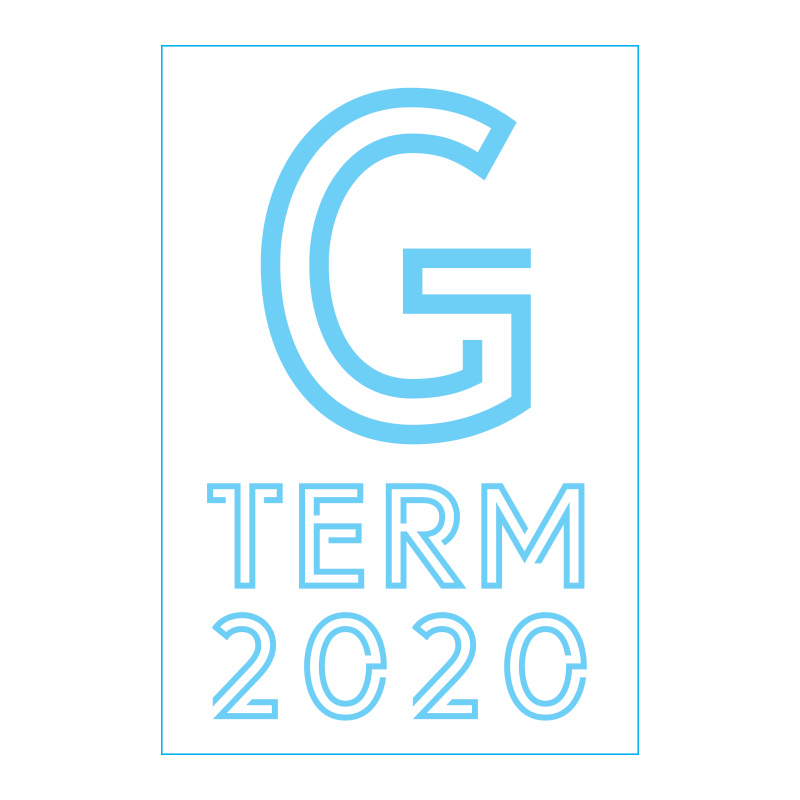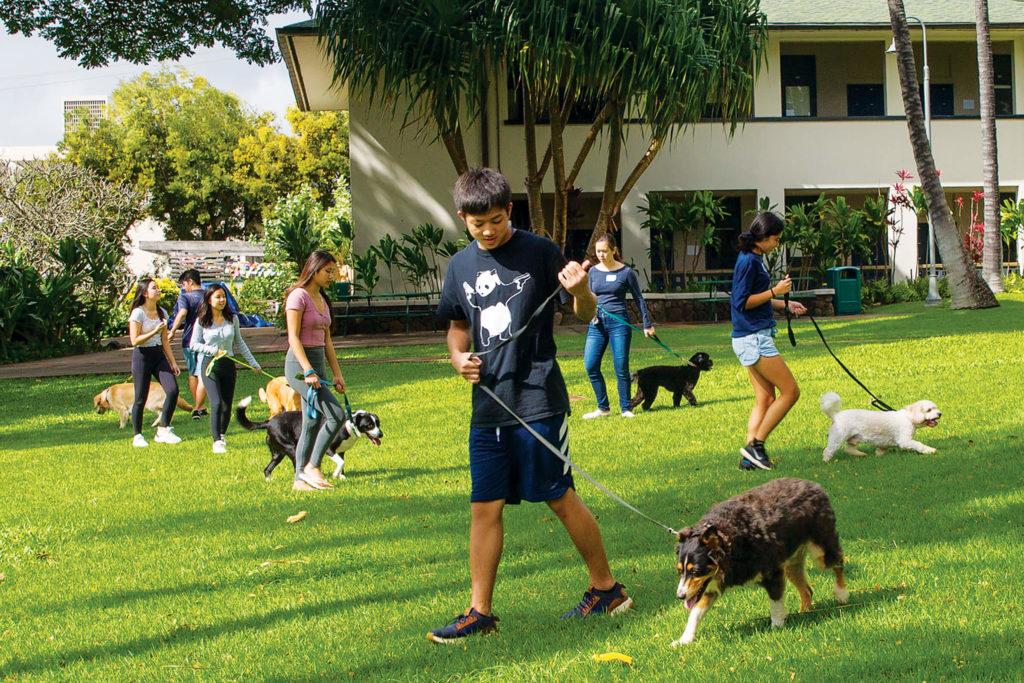
By Rachel Breitweser ’03
This year’s G-Term offered 70 different opportunities on campus, across O‘ahu and Hawai‘i, as well as around the country and internationally. The multi-day courses covered a wide range of subjects from technology, history and life skills to community service, the arts and Hawaiian culture.
Now in its fourth year, G-Term has become an essential part of the Academy experience – offering students non-graded opportunities to learn new skills and immerse themselves in experiences they might otherwise not have in the regular classroom. “It’s a way for kids to try new things they wouldn’t normally do, and teachers to teach something they’re passionate about, so everyone’s really happy to be there,” says Nanea Satterfield ’21, who participated in the Lo‘i to Table course.
In addition to exploring personal interests, students also took advantage of opportunities to make a difference in the community during the special interim, which followed winter break in early January. For instance, Satterfield and her classmates helped the nonprofit Papahana Kuaola clear a taro patch. “We’re helping organizations do work that they normally wouldn’t be able to do by themselves because they need volunteers,” she said. “It’s awesome to help.”
K A P Ō L E I
Habitat for Humanity Service Build

Students helped build a house alongside contractor supervision by assembling parts, painting and more, for a family in need in Kapōlei.
The way Habitat for Humanity works is that they build a house without labor costs – since it’s all volunteers – so it’s way more affordable for the family. It was cool to learn construction stuff. Even digging a hole was actually kind of fun. It’s really hard work and I was sore the next day, but it felt good to know that what we were doing was going to help someone so much. Everyone had a good attitude about it and wanted to help. It was cool to see. I learned that even though something can be super hard work, it can be fun if you make it, and if you look at it the right way.
– James Fujita ’21
W YO M I N G
Active Science in Grand Teton and Yellowstone National Parks

Students visited two iconic national parks, Grand Teton and Yellowstone, to learn about wildlife, climate, geology, human history and ecology in the snowy winter landscapes.
Every single day was an adventure. It was incredible because it’s just so different to be in snow. It felt really good to be connected with nature. One of my favorite parts was having time to connect with friends and people you wouldn’t normally talk to. So, for me, the biggest part of the experience was the friendships I made.
– Madi Suh ’22
M Ā N O A , K Ā N E ‘ O H E A N D H E ‘ E I A
From Lo‘i to Table

Students gained a deeper understanding of the lo‘i kalo (taro wetland) – an important component of the indigenous Hawaiian ahupua‘a – by visiting different lo‘i across the Island at Ka Papa Lo‘i o Kānewai at University of Hawai‘i, Mānoa, Hakipu‘u at Kualoa Ranch and Papahana Kuaola in He‘eia, and harvesting and preparing kalo.
I absolutely loved this experience. I’m really into Hawaiian culture. I take Hawaiian language, am a teacher’s assistant for the after-school Hawaiian immersion program and perform during Holokū. So, it was awesome to learn how we can cultivate things the way our ancestors used to. My favorite part was getting dirty in the lo‘i. Stomping around in the lo‘i mixes up the nutrients and it’s just so much fun. As a bonus, the mud exfoliates your skin so it’s baby-smooth.
– Nanea Satterfield ’21
P U N A H O U C A M P U S
Punahou Ninja Warrior

As part of this G-Term, students designed, constructed and competed in an on-campus obstacle course inspired by “American Ninja Warrior,” the high-energy competition TV series. Students also challenged themselves on the military obstacle course at Schofield Barracks and explored teamwork and tactical planning by playing paintball.
I watch ‘American Ninja Warrior,’ but before this G-Term, I didn’t put it together that, not only can you watch it, but you can do it yourself. When I first watched the show, I thought, ‘that looks doable,’ but now I understand the training that goes into it, and I see why it’s such an accomplishment. The obstacle courses were definitely challenging, and I learned that you had to use teamwork in order to do them. Going into this, I had a cautious mindset, but during it, I thought, ‘okay, I’ve never done this before, but I’m just going to try it.’ And it was really fun. Since then, my attitude has changed, and I’m more willing to take risks and try new things.
– Anya Zoraster ’20
WA I M Ā N A L O
Let’s Ride Horses!

In this course, students learned from trained equestrians how to care for horses and ride them, as well as take basic care of other farm animals.
I’ve ridden horses before, and I wanted to learn more about them. We learned how to care for them, about their diet and their anatomy. We brushed them, cleaned their hooves and learned how to saddle them. We also got to know the horses’ personalities and build a connection with them. By taking care of one before riding it, I felt more connected to the horse than if I had just gotten on one. This experience opened my eyes to how gentle and smart horses are.
– Mie Dunbar ’21
P U N A H O U C A M P U S
Positive Reinforcement Dog Training

Students learned techniques and commands for training dogs to be welcome members of any home during this experience.
I really love dogs, but I never had one as a pet. So, I wanted to get that experience of taking care of one and training it. This is the most time I’ve spent around a dog. They’re so fun to play with. There are no downsides at all. These dogs cheer you up, so, it’s therapeutic. One of the highlights was that I got to successfully teach a dog a new trick. That was so cool. When I’m an adult, I’ll get a dog and maybe I’ll still remember some of the stuff I learned.
– Reagan Kaminaka ’21
S E O U L , K O R E A A N D T O K Y O , J A PA N
Exploring and Comparing Seoul and Tokyo

Students visited Seoul and Tokyo to explore the similarities and differences between Korean and Japanese culture, history and language.
I got to see how similar these two large cities were. I’m Japanese, so I could see some of my culture from Japan and compare it with Korea. I’ve taken Japanese language classes at Punahou, but on the trip, we got to go to temples, eat foods native to the area and experience things firsthand. Speaking with students from Korea and Japan was also a good experience. We compared how our schools and lifestyles are different. I got to make new friends and be a part of the culture.
– Jeron Oshita ’20
P U N A H O U C A M P U S A N D WA I M Ā N A L O
The Ultimate Frisbee Experience

Through practice on campus and at Waimā nalo Beach, students honed their skills at Ultimate Frisbee and other flying disc games. President Mike Latham ’86 even got in on the fun, participating in the course as a student.
This G-Term was super fun. It’s my second year doing it, and I like that it’s outside. I like the freedom of the sport. You can throw the Frisbee however you want, and throw it really far, but it takes a lot of technique because sometimes you don’t know what it’s going to do unless you’re really good. We also learned how to be supportive teammates by not putting others down when they make a mistake. I can use that during school. if someone gets a bad score on a test, I can bring their self-esteem up.
– Zac Leitner ’21
K A K A ‘A K O
Medical Immersion

In this G-Term, students visited the John A. Burns School of Medicine to learn clinical skills and try simulated surgery. They also practiced solving mystery cases, heard from health care professionals and shadowed a doctor on the job.
This G-term really helps you figure out if you truly want to go into the medical field or not. It’s special because it gave us an experience a lot of people have to wait to have. I didn’t know if I wanted to go into medicine but learning how doctors treat patients helped me figure out that I want to be a family practice doctor. One of the doctors said that a big part of being a doctor is being able to talk to patients, and I think that I’ll be able to do that well. So, that made me think, I really want to do this.
– Taylor Hange ’21
